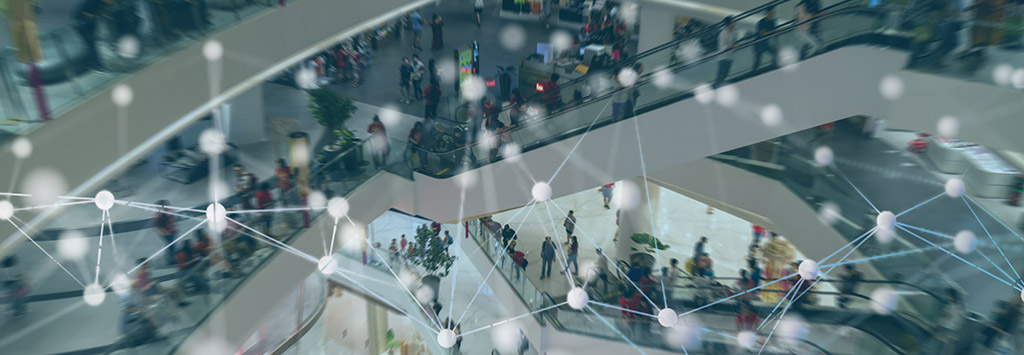Click-click, clickclickclick, click. Ah, the sound of another online purchase completed. Remember how you used to shop? In a shop? While the last 18 months of conducting our lives online have changed our purchasing habits, you might be surprised to learn that jumps in e-commerce sales, while sizable, hardly tell the whole story. The in-store retail experience is alive and well一and thriving.
According to global retail trade association National Retail Federation (NRF)’s inaugural “State of Retail and the Consumer” event and analysis, despite the increasing popularity of e-commerce, “80% of all shopping still occurs in stores,” and its revised annual forecast for 2021 projects retail sales (excluding car, gasoline, and restaurant sales) to increase between 10.5% and 13.5% to more than $4.44 trillion. In short, brick-and-mortar stores are here to stay, but in many cases, will function very differently than in the past.
For starters, stores need to be more dynamic一able to accommodate disruption in foot traffic and buying behaviors quickly and efficiently. Secondly, for many companies, the in-store channel is now a part of an omnichannel, where brick-and-mortar and digital channels coordinate to deliver a holistic brand customer experience rather than compete head-to-head for purchasing dollars.
Adjusting to the new normal will mean big changes for multi-site retailers, not only for their retail locations一but for their fulfillment centers as well一and dependable facilities management (FM) partners will be integral to their success.
Here are several key trends you can expect to see in multi-site retail going forward.
Increased Agility
To better prepare for changing conditions on the ground一coronavirus pandemic induced or not一brick-and-mortar stores will continue to make long-term changes designed to increase their functional flexibility.
For example, to minimize contact while shopping, many stores are investing in wider aisles and self-service kiosks for price check, fitting room access, order pickup, and check-out services. Touchless fixtures such as hand sanitizer and bathroom faucets are also becoming standard. And parking lots are being reconfigured to accommodate faster transactions and curbside pick up.
Such modifications better position a store to react quickly to shifts in customer expectations and reduce dependence on in-store staffing. They also support increased customer demand for so-called BOPIS, Buy Online, Pickup In-Store sales.
FM providers may be called on to assist with installing and servicing new equipment or reconfiguring internal and external spaces. Projects like these are in full swing. Some providers specialize in project work and construction specifically for these purposes and are well positioned to assist.
Richer In-Store Experiences
While it may seem counterintuitive, the brick-and-mortar sector is growing. Citing U.S. Bureau of Labor Statistics data, the aforementioned NRF analysis reports 1,045,422 U.S. retail establishments as of third quarter 2020一up 4,801 from the previous一and highest third-quarter establishment count in the last decade.
In a world of ubiquitous online data, retailers are learning consumers no longer make decisions based solely on price and access, but on more holistic experiences resonating with meaningful touchpoints, value alignments, and emotions. Richer in-store experiences are a big part of that equation.
Take Dick’s Sporting Goods, for example. Long considered the go-to for recreational sports equipment, the retailer is currently poised to launch Public Lands, a new concept store focused on outdoor activities and land conservation.
According to retail trade publication and news site Chain Store Age, Public Lands will include a 30-foot climbing wall, premium outdoor equipment and apparel, and “elevated customer service” delivered by employees who embody a love for the outdoors and commitment to protecting the country’s public lands. One percent of all sales will also be donated to local and national conservation efforts. Clearly, a visit to Public Lands will be something of an event一complete with engagement opportunities一designed to generate purchases your device at home simply can’t match.
FM partners must be ready to expand their offerings to provide enhanced service levels to support unique in-store experiences. A climbing wall, for example, will need different types of maintenance than the floor. In addition, brand standards must be consistently maintained throughout the fleet一that climbing wall in Cleveland has to be as safe and clean as the one in Albuquerque, and so on.
Reconfigured Stores for Streamlined Operations
Other retail outlets will hardly be recognizable as shopping destinations. Brick-and-mortar sites will serve as online fulfillment depots for online sales supporting the BOPIS or so-called “dark store” model.
This store as a service approach is a newer iteration of omnichannel marketing and sales, where online and in-store channels work seamlessly together to complete a sale. Since customer time spent in the store will be relatively brief, staffing needs and other costs will be significantly reduced. However, convenience一including opening hours, wait times, and even a curbside pickup option一will be key to success.
A handful of larger retailers are co-locating their in-store shopping experiences and BOPIS models under one roof. For example, Best Buy’s Store Pickup is an in-store service for customers to collect online purchases. And while it shares floor space with the main shopping area, the Store Pickup desk is uniquely branded, and conveniently located at the front of the store一no wading through aisles of tempting merchandise to get to the back. Designated parking spots are also typically part of the deal, designed to optimize convenience and efficiency rather than additional on-the-spot sales.
For FM, a dual-purpose, internally segmented retail site can add layers of complexity to day-to-day operations. Additional time and equipment may be needed to support varying lighting schemes, cleaning requirements, and equipment maintenance.
Other omnichannel models might include a rich experience flagship retail site with streamlined BOPIS-like models for regional branches. For FM partners, this will mean coordinating varying services levels across the same multi-site client.
Rethinking Supply Chains
Whether it’s an extreme weather occurrence or another exceptional event, disruption to multi-site operations will become more common. Global supply chains are especially vulnerable to unexpected dislocations.
Simultaneously, getting products to customers when and where they expect them will be an increasingly important brand differentiator一and pose significant logistical challenges for multi-site retailers. Supply chains, then, must be reimagined with a shift toward more efficient, local fulfillment solutions. Costs must be optimized across nodes, routes, capacities, and last-mile options to make purchase delivery more dependable.
FM partners will face similar issues. To support clients in delivering brand promises, FM providers must furnish them with the products and parts they need, when they need them, across their entire fleets.
Coping With Ongoing Labor Shortages
According to American business magazine Forbes, the current labor shortage in retail is expected to be around for the foreseeable future, and will be especially acute during the upcoming holiday season. The U.S. Department of Labor, as cited in Forbes, currently estimates there are nearly one million open retail positions.
Strategies to mitigate the effects in the short-term have included increasing wages, offering sign-up bonuses, and expanding benefits packages. Longer-term strategies could include permanent reductions in staff in exchange for increased use of self-service options and different business models (omnichannel, BOPIS, etc.). Regardless, operational costs will increase in the short term.
FM partners will likely face similar issues, as shortages in trade labor are also present. Those partners who are most effective will better coordinate service providers to optimize their impact on the ground. Constant recruitment while maintaining service level and compliance standards will also be important to the success of FM providers and their multi-site clients going forward.
For now, then, the future of retail appears promising, but will involve significant changes in consumer behavior and preferences. Naturally, this will continue to pose opportunities and challenges for multi-site retailers, both for their retail outlets and the fulfillment centers that serve them.
“The investments made by retailers...to prioritize safety have been definitive markers of successful adaptation during the pandemic, and the work they’ve done to enhance their omnichannel strategies [so far] better positions our industry to withstand future disruption,” confirmed Tom McGee, President and CEO of member organization ICSCin a press release earlier this year.
Partnering with an FM provider with a forward-thinking approach, industry-leading technology, strong relationships with service providers and suppliers, and deep expertise can help make the ongoing transitions required一not only to assist multi-site retail organizations in adapting, but in growing for the future, too.
This article was originally published as part of Going Far: Success in 2022 Through Integrated Facilities Management Partnership. To view the full report, you can download your free copy here.







